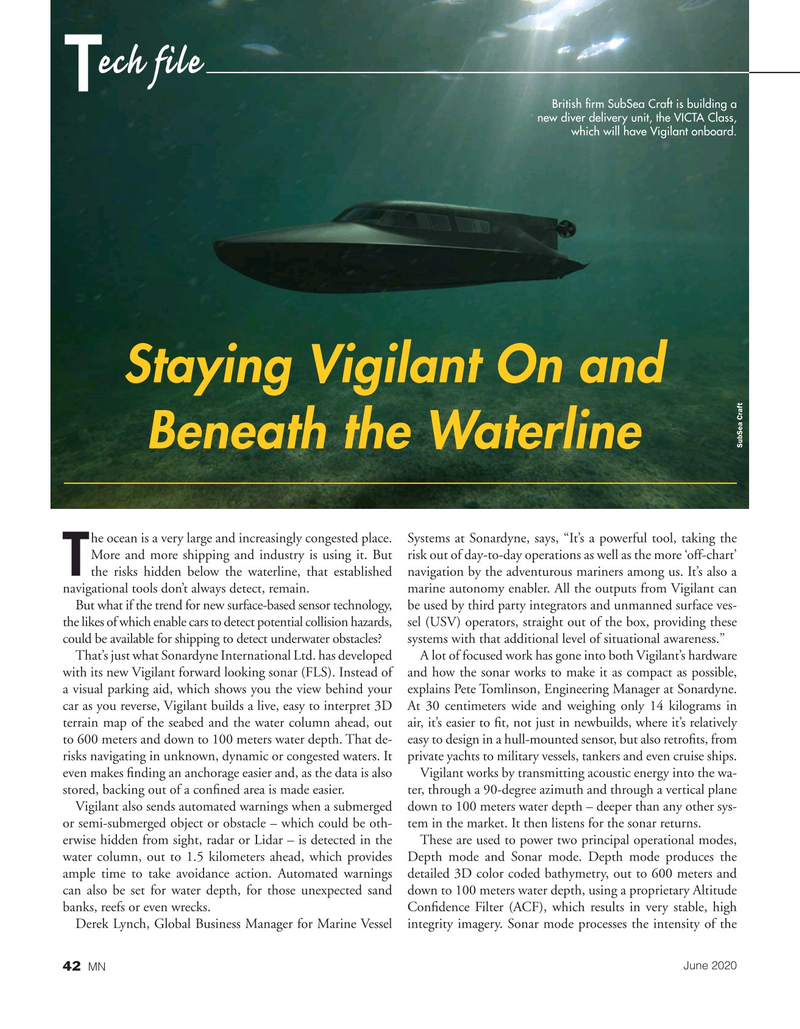
Page 42: of Marine News Magazine (June 2020)
Combat & Patrol Craft Annual
Read this page in Pdf, Flash or Html5 edition of June 2020 Marine News Magazine
ech file
T
British ?rm SubSea Craft is building a new diver delivery unit, the VICTA Class, which will have Vigilant onboard.
Staying Vigilant On and
SubSea Craft
Beneath the Waterline he ocean is a very large and increasingly congested place. Systems at Sonardyne, says, “It’s a powerful tool, taking the
More and more shipping and industry is using it. But risk out of day-to-day operations as well as the more ‘off-chart’
T the risks hidden below the waterline, that established navigation by the adventurous mariners among us. It’s also a navigational tools don’t always detect, remain. marine autonomy enabler. All the outputs from Vigilant can
But what if the trend for new surface-based sensor technology, be used by third party integrators and unmanned surface ves- the likes of which enable cars to detect potential collision hazards, sel (USV) operators, straight out of the box, providing these could be available for shipping to detect underwater obstacles? systems with that additional level of situational awareness.”
That’s just what Sonardyne International Ltd. has developed A lot of focused work has gone into both Vigilant’s hardware with its new Vigilant forward looking sonar (FLS). Instead of and how the sonar works to make it as compact as possible, a visual parking aid, which shows you the view behind your explains Pete Tomlinson, Engineering Manager at Sonardyne. car as you reverse, Vigilant builds a live, easy to interpret 3D At 30 centimeters wide and weighing only 14 kilograms in terrain map of the seabed and the water column ahead, out air, it’s easier to ?t, not just in newbuilds, where it’s relatively to 600 meters and down to 100 meters water depth. That de- easy to design in a hull-mounted sensor, but also retro?ts, from risks navigating in unknown, dynamic or congested waters. It private yachts to military vessels, tankers and even cruise ships. even makes ?nding an anchorage easier and, as the data is also Vigilant works by transmitting acoustic energy into the wa- stored, backing out of a con?ned area is made easier. ter, through a 90-degree azimuth and through a vertical plane
Vigilant also sends automated warnings when a submerged down to 100 meters water depth – deeper than any other sys- or semi-submerged object or obstacle – which could be oth- tem in the market. It then listens for the sonar returns. erwise hidden from sight, radar or Lidar – is detected in the These are used to power two principal operational modes, water column, out to 1.5 kilometers ahead, which provides Depth mode and Sonar mode. Depth mode produces the ample time to take avoidance action. Automated warnings detailed 3D color coded bathymetry, out to 600 meters and can also be set for water depth, for those unexpected sand down to 100 meters water depth, using a proprietary Altitude banks, reefs or even wrecks. Con?dence Filter (ACF), which results in very stable, high
Derek Lynch, Global Business Manager for Marine Vessel integrity imagery. Sonar mode processes the intensity of the
June 2020 42 MN

 41
41

 43
43
